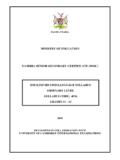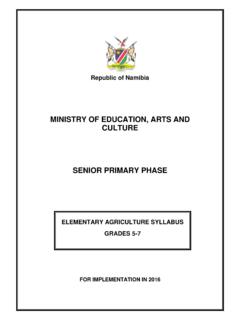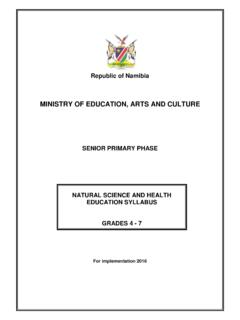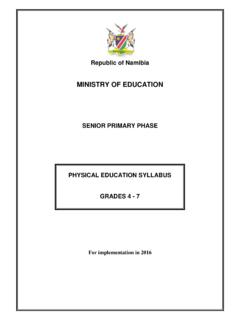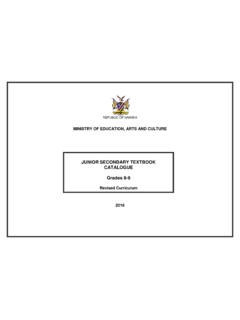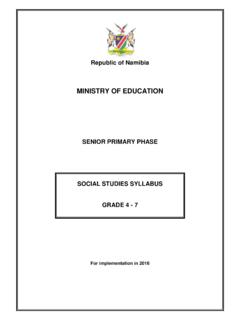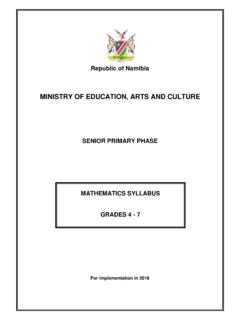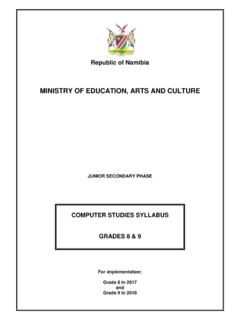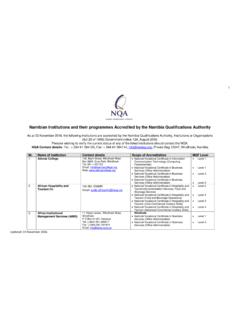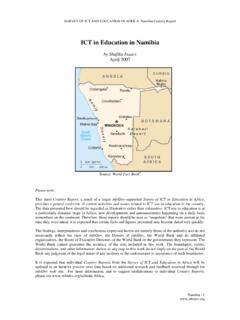Transcription of THE NATIONAL CURRICULUM FOR BASIC …
1 Republic of NamibiaMINISTRY OF EDUCATIONTHE NATIONAL CURRICULUM FOR BASIC EDUCATION2010 The NATIONAL Institute for Educational Development P/Bag 2034 OkahandjaNAMIBIAT elephone: +264 62 509000 Facsimile: +264 62 509073E-mail: NIED 2009 NATIONAL Institute for Educational Development (NIED)Ministry of EducationPrivate Bag Copyright NIED, Ministry of education , 2008 THE NATIONAL CURRICULUM FOR BASIC EDUCATIONISBN: 0-86976-911-1 Printed by NIEDF irst publication date 2009 Illustration done by Theresa Maasdorp, a Grade 12 learner at J G van der Wath Secondary School, OkahandjaTitle: Namibia Vision 2030 Explanation by Ms Maasdorp:There is a cloud of smoke, in it is the Namibian flag and at the end there is an eye.
2 This represents the Namibian cloud of vision a vision through an diagrammes within the rays (anti-clockwise from the bottom):1. The hearts hugging represent a caring society. You will notice the hearts are different colours, representing different The rubbish tin contains the burning of HIV and Aids. Total eradication or limiting the number of persons infected. It represents a healthy The bird represents freedom, the twig that grew into the word Freedom also represents the fact that freedom does not come in 30 seconds. It comes with the years, as Namibia grows. It represents a democratic The conveyer belt and the boxes represent a productive nation that exports and not just imports. We produce most of our own There are two trees and two log bundles.
3 These represent an environmentally friendly society, where the amount of raw materials used equals the amount produced. The number of trees planted equals the number of logs cut for The computers and books represent an information society. We have access to internet and information - we have books to read and to be The graduating girl and boy represent individual changes such as technology advances, globalisation, HIV and AIDS, and environmental degradation make it necessary to re-evaluate the guidelines governing the purpose and content of NATIONAL CURRICULUM for BASIC education , effective as from 2010, and which replaces the Pilot CURRICULUM Guide for Formal BASIC education (1996) as well as the Pilot CURRICULUM Guide for Formal Senior Secondary education (1998), ensures continuity of the foundation principles of the Namibian education system as described in Toward education for All.
4 A Development Brief (1993). The goal, aims, competencies, core skills and key learning areas have been identified in relation to Namibia Vision 2030 and are presented as a CURRICULUM for the framework serves as the official CURRICULUM policy for Formal BASIC education in Namibia. It guides schools on how to organise the teaching-learning process and provides a coherent framework to ensure that there is consistency in the delivery of the CURRICULUM in schools throughout the what children should learn has always been complex. A fast-developing world makes it essential that the CURRICULUM framework has to adapt to change. The knowledge, skills, values and attitudes which learners can acquire are infinite.
5 The developers have made a careful selection of the timeless and the new, in order to find a delicate balance to ensure that our CURRICULUM remains relevant. In this manner we strive unceasingly, as we always have, towards equipping the younger generation to deal with both the present and the is my wish that this CURRICULUM policy document serves as a roadmap and a companion booklet to all stakeholders in their drive to make education the success it must become. Should this happen, than a profitable and exciting learning experience beckons for our further wish to extend my appreciation to the people who contributed towards the development of this special role of teachers is central to successful CURRICULUM delivery.
6 We are confident that with the support of the Ministry and the cooperation of stakeholders, including parents and the broader community, they will empower learners to become confident, innovative, compassionate and productive members of our Mbumba, MPMinisterNangolo Mbumba, MPMinister of EducationPLEASE NOTE:This CURRICULUM is effective from 2010, and replaces the following CURRICULUM policies and directives:The Pilot CURRICULUM Guide for Formal BASIC education (1996)The Pilot CURRICULUM Guide for Formal Senior Secondary education (1998)NIED circulars: - 1/2005: Information on the Implementation of the Localised Namibia Senior Secondary Certificate (NSSC) CURRICULUM in January 2006- 1/2006: Information on the Implementation of the Revised Upper Primary and Junior Secondary Syllabuses in January 2007 NIED letters dated 13 November 2006 and 6 August 2007: - Implementation Issues on the Revised Grades 5 10 Syllabuses - Information on the Dissemination of the Revised Grades 5 - 10 issued by the Directorate Programme and Quality Assurance (PQA) with regard to Fields of Study, time allocation, requirements for promotion and internal examinations up to December NATIONAL CURRICULUM for BASIC education will be supplemented by The CURRICULUM for Special NATIONAL CURRICULUM for BASIC EducationiTABLE OF CONTENTS1.
7 INTRODUCTION 1 BACKGROUND 1 THE PURPOSE AND CONTENT OF THE CURRICULUM FRAMEWORK 1 NAMIBIA VISION 2030 1 THE CONSTITUTION AND THE education ACT 2 EARLY CHILDHOOD DEVELOPMENT AND PRE-PRIMARY education 2 THE STRUCTURE AND SUBSTANCE OF BASIC education 3 THE APPROACH TO TEACHING, LEARNING AND ASSESSMENT 4 PRECONDITIONS FOR SUCCESSFUL CURRICULUM DELIVERY 52. THE GOAL AND AIMS OF BASIC education FOR A KNOWLEDGE-BASED SOCIETY 7 THE GOAL OF BASIC education 7 THE AIMS OF BASIC education FOR THE SOCIETY OF THE FUTURE 7 A caring society 8 A healthy society 8 A democratic society 8 A productive society 8 An environmentally sustainable society 8 An information society 9 Individual development 93.
8 CORE SKILLS AND KEY LEARNING AREAS 10 CORE SKILLS 10 Learning to learn 10 Personal skills 10 Social skills 10 Cognitive skills 10 Communication skills 11 Numeracy skills 11 Information and Communication Technology skills 11 KEY LEARNING AREAS 12 Languages 12 Mathematics 12 Natural Sciences 12 Social Sciences 13 Technology 13 Commerce 14 Arts 14 Physical education 144. PHASES AND COMPETENCIES 15 THE PHASES OF BASIC education 15 Pre-Primary 15 Lower Primary, Grades 1-4 15 Upper Primary, Grades 5-7 15 Junior Secondary, Grades 8-10 16 Senior Secondary, Grades 11-12 17 PHASE COMPETENCIES AND BASIC COMPETENCIES 19 FRAMEWORK OF PHASE COMPETENCIES 20 Pre-Primary 20 Lower Primary 21 Upper Primary 21 Junior Secondary 22 Senior Secondary 23 The NATIONAL CURRICULUM for BASIC Educationii5.
9 LANGUAGE: MEDIUM OF education AND SUBJECTS IDENTITY, CULTURE, COMMUNICATION, LEARNING MEDIUM OF LEARNING LANGUAGE SUBJECTS FOREIGN LANGUAGES LANGUAGES AVAILABLE FACILITATING LANGUAGES FOR LEARNERS WITH SPECIAL EDUCATIONAL NEEDS 25 6. TEACHING, LEARNING AND ASSESSMENT TEACHING A wide repertoire of teaching roles Variation in working methods Flexible organisation of knowledge and learning A stimulating learning environment English across the CURRICULUM The gender dimension Inclusive education Positive discipline LEARNING: EXPERIENCE, REFLECTION, KNOWLEDGE CREATION ASSESSMENT Continuous assessment Formative and summative assessment Informal and formal methods Evaluation Criterion-referenced grades Grade descriptors Conducting and recording assessment PROMOTION Pre-Primary phase Primary phases and Junior Secondary phase Senior Secondary phase 367.
10 CURRICULUM MANAGEMENT MANAGING RESOURCES TEACHERS LESSON STRUCTURE HUMAN RESOURCE UTILISATION LIFE SKILLS INCLUSIVE education ORGANISING LANGUAGE TEACHING TIMETABLING MULTI-GRADE TEACHING CO-CURRICULAR ACTIVITIES COMMUNITY RELATIONS 39 ANNEXE 1: TIME ALLOCATION FOR GRADES 1-10 SCHOOLS WITHOUT COMPUTER LABORATORIES IANNEXE 2: TIME ALLOCATION FOR GRADES 1-10 SCHOOLS WITH COMPUTER LABORATORIES IIANNEXE 3: TIME ALLOCATION FOR GRADES 11-12 IIIANNEXE 4: TIME ALLOCATION FOR GRADES 8-10 FOR A 7-DAY CYCLE IVANNEXE 5: TIME ALLOCATION FOR GRADES 11-12 FOR A 7-DAY CYCLE VANNEXE 6: RELATIVE WEIGHTING OF KEY LEARNING AREAS BY SUBJECT VIANNEXE 7: SUBJECT SYLLABUSES VIIANNEXE 8: BACKGROUND DOCUMENTS TO THE NATIONAL CURRICULUM FOR BASIC education VIIIANNEXE 9: GLOSSARY OF TERMS USED IXThe NATIONAL CURRICULUM for BASIC Education11.

